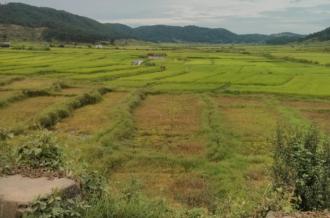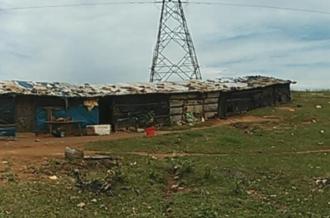The child miners of Meghalaya
Thousands of children risk their lives to work in “rat hole” mines in northeastern Indian state, earning $60 a week.

Jaintia Hills, Meghalaya: Pemba Tamang slides on his bright red gumboots, fits a torch to his head and says a little prayer. “God, please bring me back out alive.”
He walks out of his tarpaulin shack wielding a pickaxe and swaggers across monsoon green hills to a 15-meter-deep pit dug crudely into the earth.
He will spend the next seven hours here, crouched deep inside a “rat hole” less than a meter high digging for coal. “You have no control over your life here,” he says. “Because you never know when you’re going to die.”
Death is not something most 17-year-olds think about, but it has lingered over Pemba ever since he was eight, when he first came to Jaintia Hills in India’s northeast to work in the coal pits.
His father had just died from tuberculosis. Still nursing a five-week-old baby, Pemba’s mother moved the family from their dirt-poor village in neighbouring Assam state to the lucrative mines of Meghalaya so she could earn money selling food to truck drivers and labourers.
But it was never going to be enough to feed her three growing boys, and soon Pemba and his older brother started working in the “rat holes”, earning about $60 each a week to support their family.
Impulse, a local NGO fighting child labour in Meghalaya state, estimates there are around 70,000 children like Pemba who work in the mines, either digging for coal or loading thousands of trucks bound for the energy-hungry industrial sector across India and into neighbouring Bangladesh.
Illegally trafficked
Hasina Kharbhih, the founder of Impulse, says she’s discovered children as young as five working in Jaintia Hills.
The mines are so small and narrow that only someone the size of a child can squeeze inside to extract the coal.
|
|
| Web Exclusive: Indian child miner tells his story |
Most of the under-age workers have been illegally trafficked into the region from Nepal and Bangladesh by agents working for mine owners.
Desperate families are promised handsome salaries in exchange for their children’s work, but they often have no idea that they will end up living in dangerous, slave-like conditions in Meghalaya.
“Many of the families out there are still looking for their children,” says Kharbhih. “They haven’t heard from them for the last two or three years.”
Some of these families at least will never see their children again. A few years ago local newspapers reported the discovery of skeletons inside mine shafts. They are believed to be those of children who worked there, but there has been no inquiry or arrest.
Many of the families out there are still looking for their children
“Children have been dying in these rat holes and the dead bodies are not actually being taken back because it’s not possible. There’s no way they can get them out. And they are not being reported because in the context of our state, they’re illegal migrants,” says Kharbhih.
Pemba is terrified of suffering the same fate.
“I’ve seen four accidents,” he says squatting on a pile of coal. “There was this one guy who would always sit there in the mine chewing betel nut. One day this enormous rock fell on him and crushed his head. We sent his body back to the village. He had a wife and two kids.”
Pemba laughs out loud when asked about compensation for the man’s family. “The owners give money to the managers and the most the managers give in compensation is Rs5000 ($80) or Rs6000 ($96). This man lost his life. What can you do with this much money?” he says.
“I’ve seen guys break their legs and crack their heads open. I don’t want these accidents to happen to me because then I’ll be crippled.”
Pitch dark and dangerous
But there’s little Pemba can do to protect himself. Armed with his red boots and a pickaxe, he disappears into a black cave that has been carved into the side of a mountain. He struggles to pull a large wooden crate as he walks crouching further into the mine.
Inside, it is frightening. The workers say they can almost feel the weight of the mountain above bearing down on their bodies. It’s damp, pitch dark and dangerous.
With only a small head torch to guide him, Pemba picks coal off the walls and fills his crate, all the while struggling to breath in the sulphur rich air. The ceiling touches his head even as he squats. The only thing holding it up is a strategically placed wooden log.
 |
| Children as young as five work in Jaintia Hills [Karishma Vyas/ Al Jazeera] |
It is common for these “rat holes” to suddenly flood, or for parts of the mine to cave in altogether. Workers, including children, have been buried alive, or trapped without any hope of rescue.
Activists say these conditions are inhuman and inexcusable. Coal mining generates millions of dollars a year in Meghalaya and contributes up to 10 percent of the state’s gross domestic product.
Yet, there is no investment in the industry or in the workers, who labor without safety equipment, health cover or insurance.
Child rights advocates are demanding mine owners use modern, mechanical methods to dig for coal, so children would no longer be needed.
Despite requests for interviews with several state government representatives, including the ministers for social welfare and labour, no official was available to answer questions about the children working in Jaintia Hills.
Polluting state resources
However, Dolly Khonglah, a local coal exporter and the secretary of Meghalaya’s International Exporters Chamber of Commerce, struck a belligerent note.
She seemed furious that her industry was being criticised for polluting the state’s natural resources and for putting lives at risk.
“We have the stock of minerals that is God-gifted in our own private land,” she said, surrounded by pro-mining protesters waving placards. “With this we are exporting to Bangladesh, we are fetching foreign exchange for the government of India, we are paying royalty. We are fetching revenue for the state government. We are providing employment to all the boys and girls.”
 |
| Parents often have no idea that their children will end up living in dangerous, slave-like conditions [Karishma Vyas/ Al Jazeera] |
But when asked about children working in coal mines, she denied any knowledge.
“Under limestone in Nongtalang elaka (village) there’s no child labour at all. You can quote me in any international news I don’t mind that,” she insisted.
“We are not concerned with coal mining because we are dealing only with limestone.”
Al Jazeera visited three out of the 5000 individual coal mines that operate across Jaintia Hills and met several child miners aged below 18 years.
The youngest was 11-year-old Lakpa Tamang from Nepal whose own father had died in a mine accident.
Pemba Tamang, who is not related to Lakpa, knows that children work in the coal pits because he’s one of them.
He had dreamt of a very different future, but his aspirations have been tempered by fate. Now, his only dream is to own a small piece of land that he can farm. Out in the open air, far above the mines.
“In my heart I still feel like going to school but what can I do?” he shrugs.
“I wanted to be a really good doctor, but fate didn’t let me do all this.”
Follow Karishma Vyas on Twitter: @KarishmaTV
This feature is a part of our ongoing special India coverage. To read more stories click here.